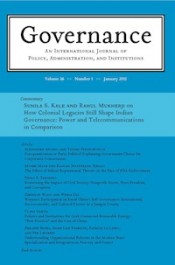Hale on “What is governance?”
 Thomas Hale of the Blavatnik School of Government, University of Oxford, responds to Francis Fukuyama’s “What is governance?”:
Thomas Hale of the Blavatnik School of Government, University of Oxford, responds to Francis Fukuyama’s “What is governance?”:
Francis Fukuyama’s commentary puts forward a basic and important point with his usual clarity. The capacity of government agencies to implement policy varies across countries and sub-national jurisdictions, affecting the life chances of those who live within them. Yet political scientists have somewhat confused ideas of how to conceptualize this variation, and correspondingly weak empirical measures for it. I can only heartily agree with Fukuyama and the other commentators that better study of the effectiveness of the functional apparatus of government would advance our understanding of how policy works.
However, at the risk of provocation I would suggest that this important project is not an answer to the question of what governance is, nor should it be. “Governance” is both too small and too big a concept to fit the task. The distinction is substantive as well as semantic.
First, “governance” is too big a term for Fukuyama’s project because government agencies are just one of several types of organizations that make and enforce rules, provide public goods and services, and otherwise govern in the sense Fukuyama means. It is commonplace today to observe that NGOs, international organizations, private companies, social enterprises, and other types of organizations have joined government agencies in the task of “governance” across every policy area, domestic and international. In some cases these organizations are the delegated agents of the state, in some they are equal partners, and in others still they lead policy formation and implementation.
Recognizing this growing pluralization of governance need not force us into facile arguments that assume a zero-sum relationship between the state and other forms of governance, as were common in the 1990s. In most cases government agencies remain the most central actor, but in very few cases are other types of governance organizations so unimportant that we can reasonably ignore them. Rather, the intellectual challenge is to map this varied landscape of governance organizations, to explain why the mix of public, private, and hybrid institutions varies across issue areas, time, and place, and to assess their implications.
Within this context, the project Fukuyama proposes is surely one of the most important tasks. But it is a subset of the study of “governance.” Moreover, it seems to me that there is more at stake here than just conceptual clarity, as the quality of a government agency surely depends on the broader context in which it operates. In advanced market democracies, bureaucrats must be good at contracting service providers, monitoring and assessing service delivery, orchestrating voluntary actions, and other tasks far outside traditional remit of “command and control.” In weak states where international organizations, NGOs, and public-private partnerships serve as functional substitutes for government agencies, the quality of government services must no doubt be measured by alternative criteria. And for all issues characterized by interdependence, government agencies must coordinate across borders—with each other, but also with other actors—to achieve effective policy implementation.
Second, Fukuyama’s approach to “governance” is too small because the factors that Fukuyama highlights do not seem to aggregate particularly usefully. The additive measures like the WGI that Fukuyama criticizes mix many things together. And as his brilliant appendix on the measurement of Chinese governance shows, the things they add together are not always very clear. The more conditional approach suggested by Fukuyama is therefore much more promising. But to the extent he is right that different parts of “good governance” are conditional on each other, we should have diminishing hopes for creating panel data, and thus for employing the powerful analytic tools it allows. Datasets like the WGI blithely ignore this trade-off, focusing on data-generation rather than measuring concepts accurately (there may be some use for the measures they aggregate, though I tend to agree with Fukuyama’s critique).
I was somewhat unclear, though, from this commentary, how much Fukuyama himself recognizes this tradeoff between, crudely, breadth and accuracy. What would a good, comparable measure of the quality of government agencies look like? Can we imagine a feasible one? I would argue that what we mean by the quality of governance must change depending on the specific research project at hand. “Good” is not a very useful criterion. I would therefore suggest that any data-gathering project that follows from this commentary make sure the dataset it builds is highly modular. That is, it would seem to be important to measure various characteristics of government agencies at the most disaggregated, specific, objective level. This would allow researchers to build their own indices of good governance, tailoring cross-country measures to the research question was at hand, instead of picking a fuzzy number from a fuzzily defined concept.
Thomas Hale is a postdoctoral research fellow at the Blavatnik School of Government, University of Oxford. He holds a PhD in Politics from Princeton University, a masters degree in Global Politics from the London School of Economics, and an AB in public policy from Princeton’s Woodrow Wilson School.
